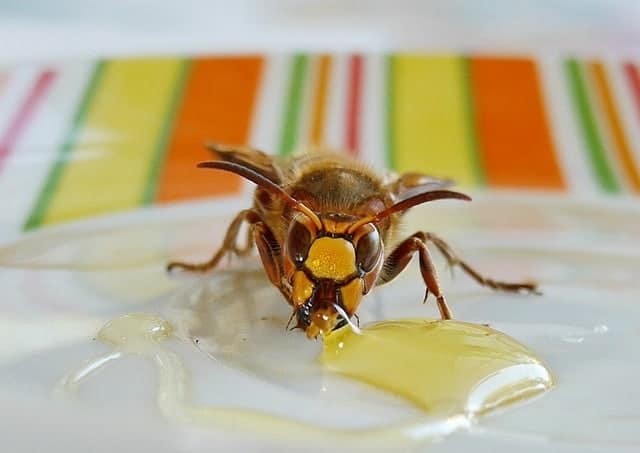Wasps, hornets, and bees are closely related to each other. They are colonizing Hymenoptera, which are most active in summer. However, they differ not only in their size but also in their way of life and food.
A distinctive property of bees is the formation of honey, which is mainly used for the development of the offspring.
But what about the wasps and hornets? Do they make honey too? How does it work and when does it happen? Do wasps eat honey?
How is honey made?
Honey is a purely natural product that cannot be produced by humans. It is made from plant nectar, pollen, or honeydew and is formed in the honeycomb of the bees through repeated fermentation.
Bees produce honey to nourish the offspring and to build up reserves. It is used in winter as an energy store and ensures the survival of the entire bee colony.
Through fermentation, honey has a multitude of unique ingredients (such as enzymes) that make up its special properties. It is considered anti-inflammatory, healthy, and beneficial for the immune system.
Due to the repeated enrichment with bees’ own substances, honey has a naturally high amount of antioxidants. These enable particularly long storage and guarantee almost infinite shelf life.
Do wasps or hornets make honey?
Wasps and hornets do not produce honey. The wasp state dies at the end of summer and only the queens survive in rigor until spring. Wasps and hornets do not need honey to supply the state with energy during the cold season.
In summer, wasps mainly use small insects and other microorganisms for breeding. These are hunted, cut up, and fed to the larvae.
However, wasps feed not only on animals but also on plant juices and honeydew. They do not use these for the production of honey but use them as pure energy sources.
What are honey wasps?
Honey wasps (also known as pollen wasps) are a subfamily of wasps that use pollen to raise their offspring and accumulate in the combs. This behavior is similar to that of bees. However, no honey is produced in the process. This would only arise through repeated fermentation in the honey stomach.
Honey wasps require very warm and mostly dry environmental conditions and are common in South and North America. They do occur in very dry regions of California. Individual genera are native to the Mediterranean region. These are often specialized in a certain type of flower.
They have also adapted physically to their living conditions and developed a proboscis that is not otherwise found in wasps. They also differ from many species in that they have a solitary way of life (i.e. not living in a state, but living alone).
Honey wasps are rare, non-native wasps that use pollen to raise their offspring, but do not produce honey.
What do wasps eat?
The species diversity of the wasps is also reflected in the choice of food.
Small insects such as flies, spiders, aphids, mosquitoes, larvae of all kinds, and even bees are very popular. These are hunted by the wasps and used in particular to feed the offspring.
Wasps not only hunt but also like vegetal food. Plant juices and honeydew are on their menu. Both consist of a sugary liquid that is ingested by the wasps and used for their own energy production.
Do wasps eat honey?
Wasps like high-energy sugary liquids and also feed on honey when it is available. While this is only possible by entering a beehive in the wild, better opportunities arise around people. You can observe this regularly in summer when food is unprotected in the open air.
The wasps will not only rush to the protein-rich foods (such as meat and sausage) but will also repeatedly approach foods with a high content of sugar (such as honey and jam).
In this (in Germany made) video you can see the wasps devour a whole bowl of honey:
Do wasps steal honey?
Wasps have limited access to honey in the wild. This only exists in beehives and is well defended. Wasps are bigger and stronger than bees, but they rarely stand a chance against the overwhelming number of bees.
The bees defend their nests with their lives and do not allow wasps into their burrows. An ‘assault’ wasp is quickly attacked and enveloped by the bees en masse. This increases the body temperature of the wasp, which dies when it reaches 47°C (116°F).
More on: Can Wasps Die From Heat? (Facts You Should Know)
An unsuccessful approach to a honey depot can be seen here:
An attack by wasps on a bee colony is only successful if a larger number is involved in the attack. Normally only individual weak bees are caught at the entrance and the decimation has little effect on the entire bee colony.
The Japanese giant hornet (hornets are a species of wasp), which is not native to us, is an exception and manages to kill an entire bee colony with 30 fully-grown specimens.
This terrifying spectacle can be seen here:

